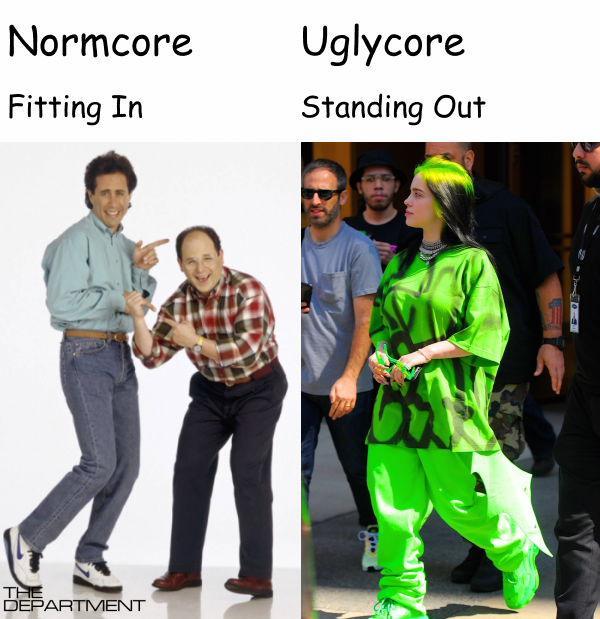︎︎︎episode 46
Those CraZy KidZ: The Gen Z Aesthetics (pt 1) - Uglycore, Normcore, Authenticity and Perfection Fatigue
June 15th, 2021
︎︎︎︎ Listen on Apple
︎︎︎︎ Listen of Spotify
︎︎︎︎ Listen on Stitcher
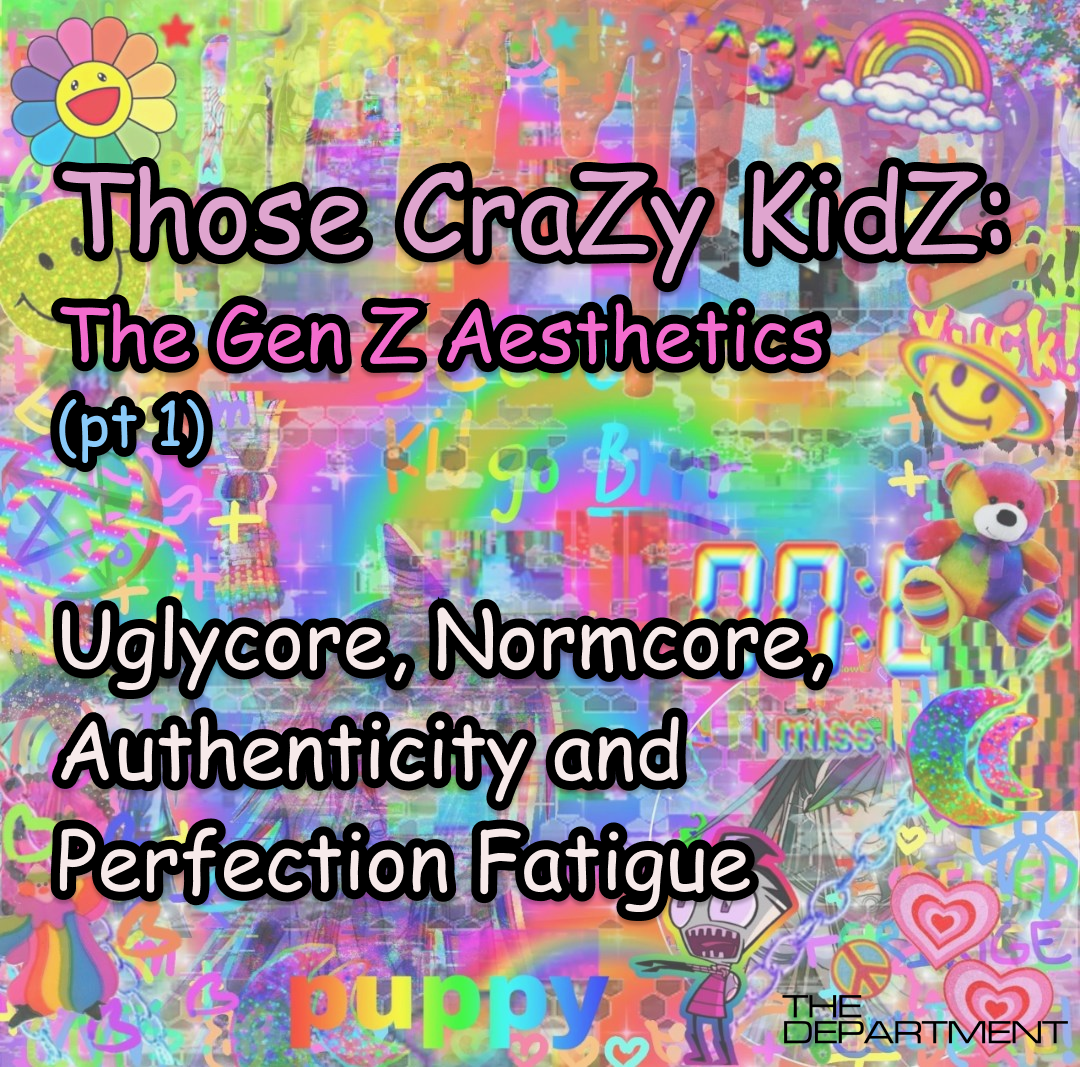
Those CraZy KidZ
I was inspired by Amanda’s series on Basic and Chuegy and the Gen Z is rebelling against the last decade’s trends and thought this would be such a great follow up to the last mini series while we all still have Cheugy on the mind. Cheugy was rather polarizing and fascinating to our community on Instagram. Really awesome to see so many people get so interested and vocal about their thoughts and thinking in unexplored ways!
This mini series we reflect on things that Gen Z thinks is actually cool and what they have been popularizing. Obviously whoever sits in the teens and 20’s becomes the influencers for all of the generations. GenZ has moved into this position of super influencers for the first time in the last year or two. It is really on every industry persons lips - which is so interesting from our perspective as we catered to Millenials for over a decade - this new generation has been brought up in a totally different world then the millennials and have a totally different perspective as well as values shaped by a world of uncertainty, racism, classism, sexism, political turmoil, environmental dangers and so many other things that create this extremely different group of individuals - who are so insanely connected by technology - more so than even the millennials.
Last week we talked about how not to be Cheugy - first and foremost - listening to the Department Podcast for one, but also being generally more conscious like thrifting, making your own clothes, being anti-capitalist, DIYing and crafting, home decorating NOT from Target, etc.
But there is so much more to the trends based on the zeitgeist that I am going to dig into and Amanda jump in any time!
Ugly fashion and ugly aesthetics
So the first trend I am going to dig into is something we have mentioned a few times on this podcast but haven’t taken a good old fashioned The Department look - which is Uglycore or “ugly” fashion and “ugly” aesthetics.
Ugly core is GenZs revolt against the manufactured and clinical minimal aesthetic (aka Blanding) ushered forward by the Millennial Generation. Gen Zer’s or Zoomers are embracing a very opposing aesthetic that has been called Ugycore which is essentially purposely and intentionally consuming and visually pushing an unedited, raw style as well as wearing traditionally ugly fashion...and i say traditionally as they were deemed ugly by the generation before them. Now Uglycore didn’t come out of nowhere...Normcore was the predecessor and i can safely say that:
Normcore crawled so the Uglycore could run.
Normcore (for anyone not aware) was an anti-fashion trend that hit its apex in 2014 and really lasted a few years- with a 90’s style average “normal” Sienfeldian fashion aesthetic featuring sweatshirts, mom or dad jeans, white sneakers, and birkenstocks and is defined as the desire to fit in rather than stand out with deep roots in nostalgia and resurgence of 90’s heritage brands.
New York Times has a story from 2014 called The New Normal that describes the synthesis best: “As envisioned by its creators, “normcore” was not a fashion trend, but a broader sociological attitude. The basic idea is that young alternative types had devoted so much energy to trying to define themselves as individuals, through ever-quirkier style flourishes like handlebar mustaches or esoteric pursuits like artisanal pickling, that they had lost the joy of belonging that comes with being part of the group. Normcore was about dropping the pretense and learning to throw themselves into, without detachment, whatever subcultures or activities they stumbled into, even if they were mainstream. “You might not understand the rules of football, but you can still get a thrill from the roar of the crowd at the World Cup,”
Normal and Ugly for that matter is of course in the eye of the beholder and SUPER subjective - what was once shunned by the fashion industry Normcore made cool. As an attempt to stand out and continue to push the boundaries on personal style - influencers and Millenial early adopters challenging the traditionally unacceptable and weaponizing instagram and their status as fashion forward. Much of this trend was also rooted in Nostalgia for the 90’s minimalism that was originally intended as deliberately looking like you aren’t “selling out” - but recreated 20 years later. The Fader had an article from 2014 called Social Anxiety: Why Basic Culture Is Just Normcore 2.0 by Emily Friedlander that says it best “ hipster culture had become so colonized by the mainstream that hipsters were beginning to differentiate themselves through the adoption of mainstream styles and tastes, crowded out of their own game in a world where being "different" was becoming the norm.”
She goes on to compare Normcore with Basic culture arguing that they are in essence the same thing even though they are coming at self-definition, identity and personal style from opposing sides of the mainstream/subcultural divide. Citing very eloquently:
“The one may be obsessed with Ugg Boots and French manicures, and the other with Tevas and Umbros, but both are examples of locating "cool" in unexpected places, of feeding the trend cycle with new materials to feast itself on and then discard. Neither represents a permanent solution to the problem of affirming one's individuality and uniqueness in a world where everybody is trying to do the same thing, imprisoned as we are within a virtual ecosystem that encourages us to express ourselves by sharing the things we "like." It's definitely a first world problem—after all, not everybody has the privilege of worrying about whether they come across as "too mainstream" or too "niche"—but I also think it's an outgrowth of a very human need, and one that we need not necessarily be ashamed of. We long to be appreciated for our particularities as humans, but we're trapped in an uphill battle of having to express those particularities through things.”
Reminds you of our hipster culture right? A whole subculture defined by what a person consumes! It also springboards right into the basic conversation which was also all about self identity through the lens of consumption. Nothing to do with who the person is on the inside, their values their dreams - it is all so surface.
So our last few episodes were about Cheugy and Amanda went into incredible detail discussing the concept of “basic” and how it relates to our culture as a degrading term for so many reasons.
This can’t go without bringing up Amanda’s preaching of Taste as a Classist Construct. Normcore has some classist issues, even racial issues - I read a rather dense article from E-flux they talk about how- Normcore was “class tourism” in its appropriation of Middle American tourist style. And “Normcore smuggles in the backdoor an implicit idea of what is normal (white, middle class) even as it shuts the front door on the mainstream.”
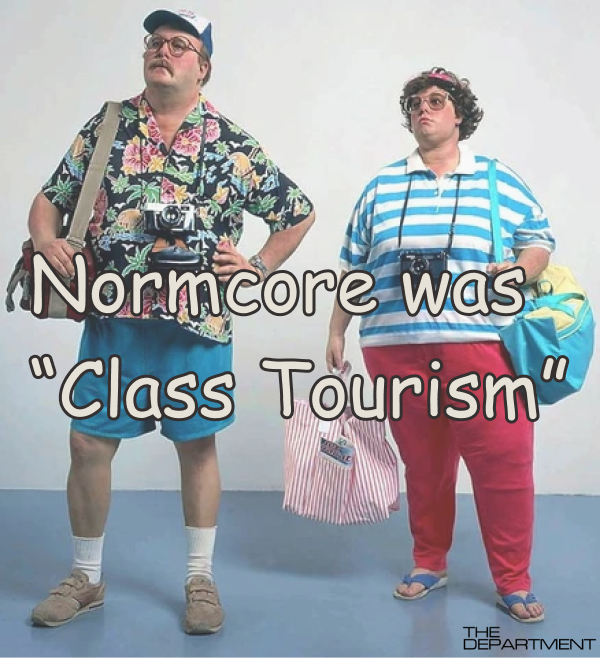
I do have to admit - There was something rather financially freeing and accessible about the trend, for the first time in so long - which was refreshing with mainstream brands being more affordable like Champion, Nike dad sneakers, etc. But of course the designer brands picked up on the trend so you could always get the high ticket aspirational version of the Normy style if you so desired.
Don’t even get me started about Menocore - which was this concept of embracing aspirational post menopausal style trends from upper middle class favorites like Eileen Fisher and Donna Karan that also was getting popularized this time.
This “ugly” trend has really been building since 2017 - maybe a little earlier and picked up where normcore left off - as normcore that essentially normalized “ugly” or post-mainstream nostalgia fashion. Turtlenecks, nobrand jeans, patagonia fleece, tevas and birks - which opened up the door to things like Crocs (side note I felt like Crocs were ruined for so long because Mario Batallio wore them - who has been cancelled for being a total creep). Normcore also normalized comfort which was the opposing trend to the Gaga maximal extremist fashion of the mid to late aughts and Kardashian bodcon high heel sex symbol of the aughties. Trends burnout and fliplop and that is the game here….So “ugly” has foundations in Normcore but it’s approach can be much more Maximal while keeping comfort in the mix. It is also about this mix of standing out vs blending in because ugly is not mainstream - it can also be achieved more accessible like Normcore - you don’t have to shop at Gucci - you can curate your ugly style through resale and vintage channels or more affordable brands like Crocs - with accessibility being a core value of the generation.
Fashionista had an article during the rise of the Ugly trend called WHY EVERYONE IS INTO UGLY FASHION: AN EXPLAINER in the article the writer Andrea Cheng interviews a trend forecaster Megan Collins from Trendera a firm that analyzes trends through a generational lens who explains “ugly fashion' means 'not the mainstream' — it's not what everyone's wearing, it's not what the general population deems as 'in' right now."
The article goes on to expose some of the reality - that yes Normcore ushered in the acceptability of trends that culture has dismissed for years as being the opposite of fashion but as the writer of the article Andrea Cheng learns that because of social media, trends cycle faster and faster to the point of an inaccessibility of things to pull into the loop so people are casting their nets wider and wider - and I quote “And it's exacerbated by an overwhelming fear of and aversion to being basic (in other words, to be mainstream). It's the ultimate insult to a fashion insider.” This is echoed in multiple interviews with fashion editors and instafamous people who mention this. One fashion editor from Marie Clare that she interviews says “You are ostracized in this industry for being basic.” So there you have it again - this comparison and fear of the concept of BASIC especially to early adopters and trendsetters as trends move so quickly you don’t ever want to be caught suddenly off guard and doing or wearing something that is by definition - Basic.
Which is ultimately so ironic because 10 years ago crocs and champion sweatshirts would have been considered absolutely condemnable in fashion circles and now they are the height of cool.
Remember that when this trend emerged the mainstream trend was and still is the manicured perfection of Millennial design and Blanding. If you haven’t listened to our episode on Blanding I encourage you to go back and take a listen! But as mentioned in our Blanding episode as well as in our Maximal episode - trends love to flipflop - you can’t be minimal forever, forces always demand the opposite after sometime. So it makes sense that we have flopped quickly to “ugly” - which really isn’t “ugly” it is authentic, relatable, and what was the unified trend and mainstream comprehension of beauty for so long - Clean, sans serif minimalism and highly Millennial. Gen Z is challenging that and are eclipsing Millennials as the new key cool kids in town
The trends have started both on the runway with Gucci, Vetment and Balenciaga leading the charge in gawky, mixed prints, tongue in cheek and geek chic - but also in the bedrooms of the GenZ kids as they have taken to shopping resale market places looking for unique clothing with an effort to embrace the 90’s - but not just the minimal version that Normcore loved but the Maximal versions as well. Self expression through the vintage market has replaced some of the fast fashion menu so they can stand out from their peers and develop a style all their own.
Ypulse a trend forecasting agency reported that 70% of 13-36 year olds say that it is cool to wear clothing that was once considered ugly. They also report that 73% of 13-37-year-olds agree with the statement “I don’t care about fashion trends; I just wear what I like,” and only 18% would call their personal style trendy.
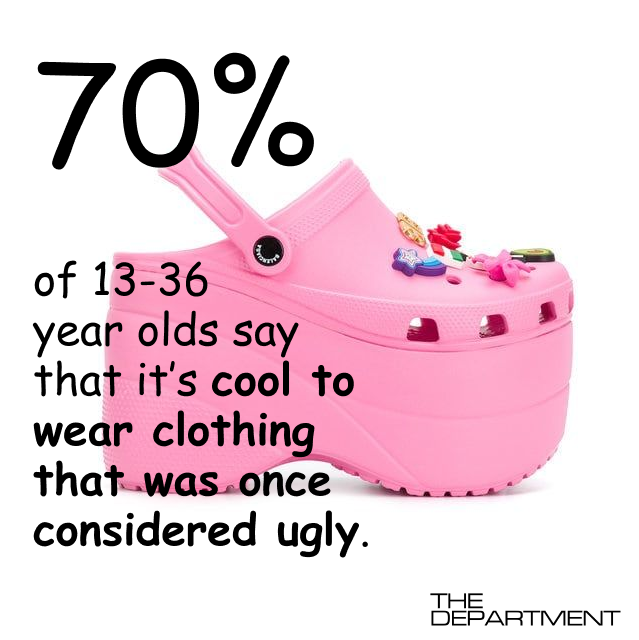
Back to Crocs - The brand is coming off a record breaking sales quarter totaling $460 million during the first three months of the year, and Crocs’ chief executive notes that sales for the shoe are “stronger than ever,” and is preparing for Crocs’ annual sales to rise more than 50% in 2021. Which is INSANE growth for really an established brand.
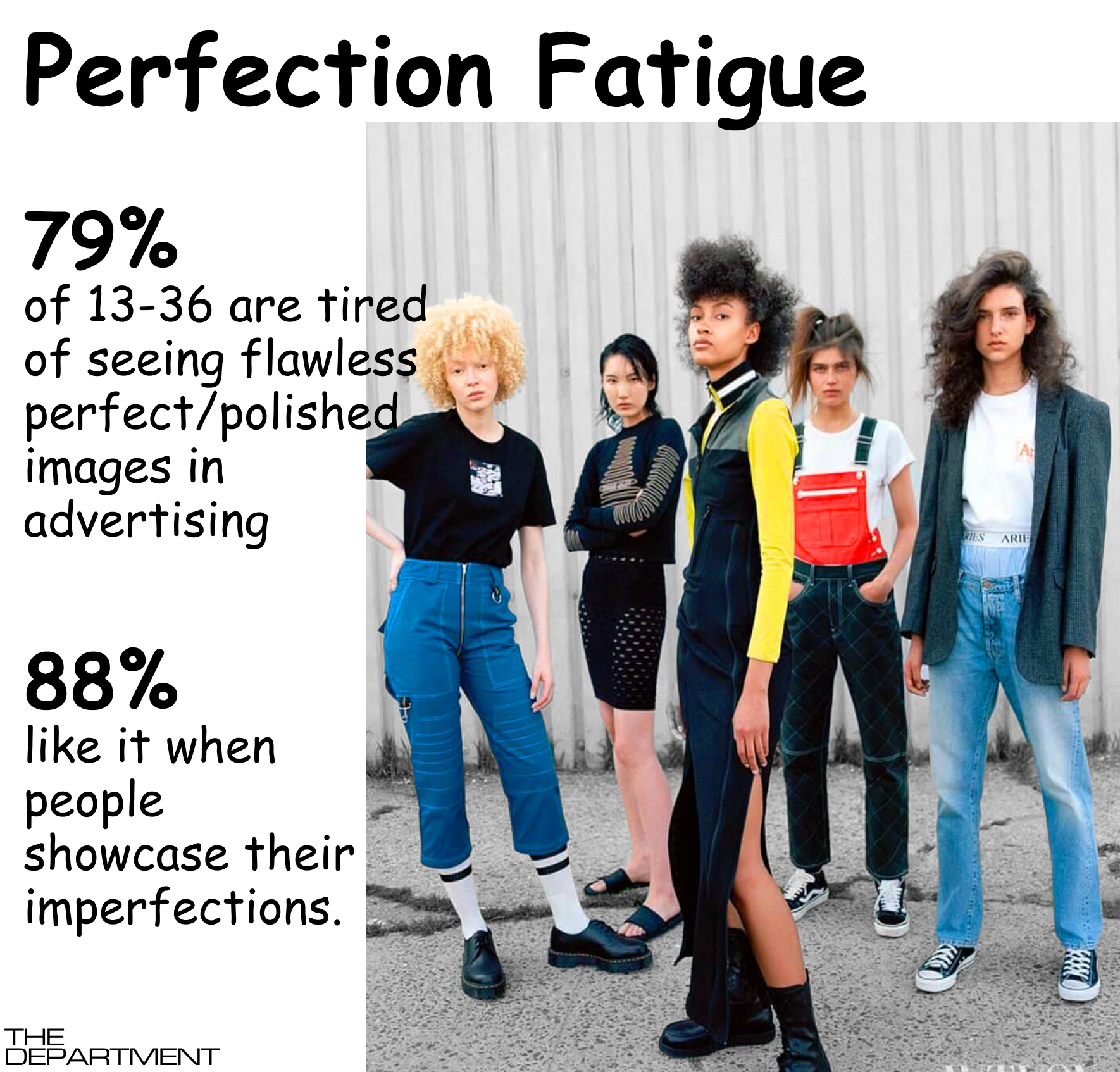
But it isn’t just the fashion that is considered ugly - the aesthetic of ugly is also crossing through all visual and social media. Gen Z and some millennials are reporting something they call “Perfection Fatigue” and are preferring to go rogue with their feeds and posts developing imperfection, purposely disheveled or intentionally ugly content. Ypulse reports that 79% of 13-36 are tired of seeing flawless perfect/polished images in advertising and 88% like it when people showcase their imperfections. It is a uniqueness and this authenticity that is in the driver seat here - and perfect feeds with perfect photos are decidedly uncool.
In 2019 Taylor Lorenz the queen of social media trends said in an Atlantic article that Gen Z is rebelling against the constraints of minimal and perfect and most of the influencers that are hot like Emma Chamberlain are posting with an unfiltered and unedited vibe. And I quote “While Millennial influencers hauled DSLR cameras to the beach and mastered photo editing to get the perfect shot, the generation younger than they are largely posting directly from their mobile phones.” Gawky, awkward and relatable - even using filters that make you look WORSE is considered cool.
Don’t get me wrong - style and status are still important - but the fight for equality as well as sharing and showing compassion for others is an important part of the social sphere - where the millennials were passionate about the perfect feed - GenZ doesn’t hold aesthetics in quite the same regard. Community, likes and dialog is coming out of shows of empathy over a beautiful image.
Essentially, between “ugly fashion” and “ugly aesthetics” it all comes to one point - GenZ are influenced by comfort and authenticity that promotes self-acceptance over perfection. They also want to rebel against the millennial mindset and choices as they move into the influencer role.
